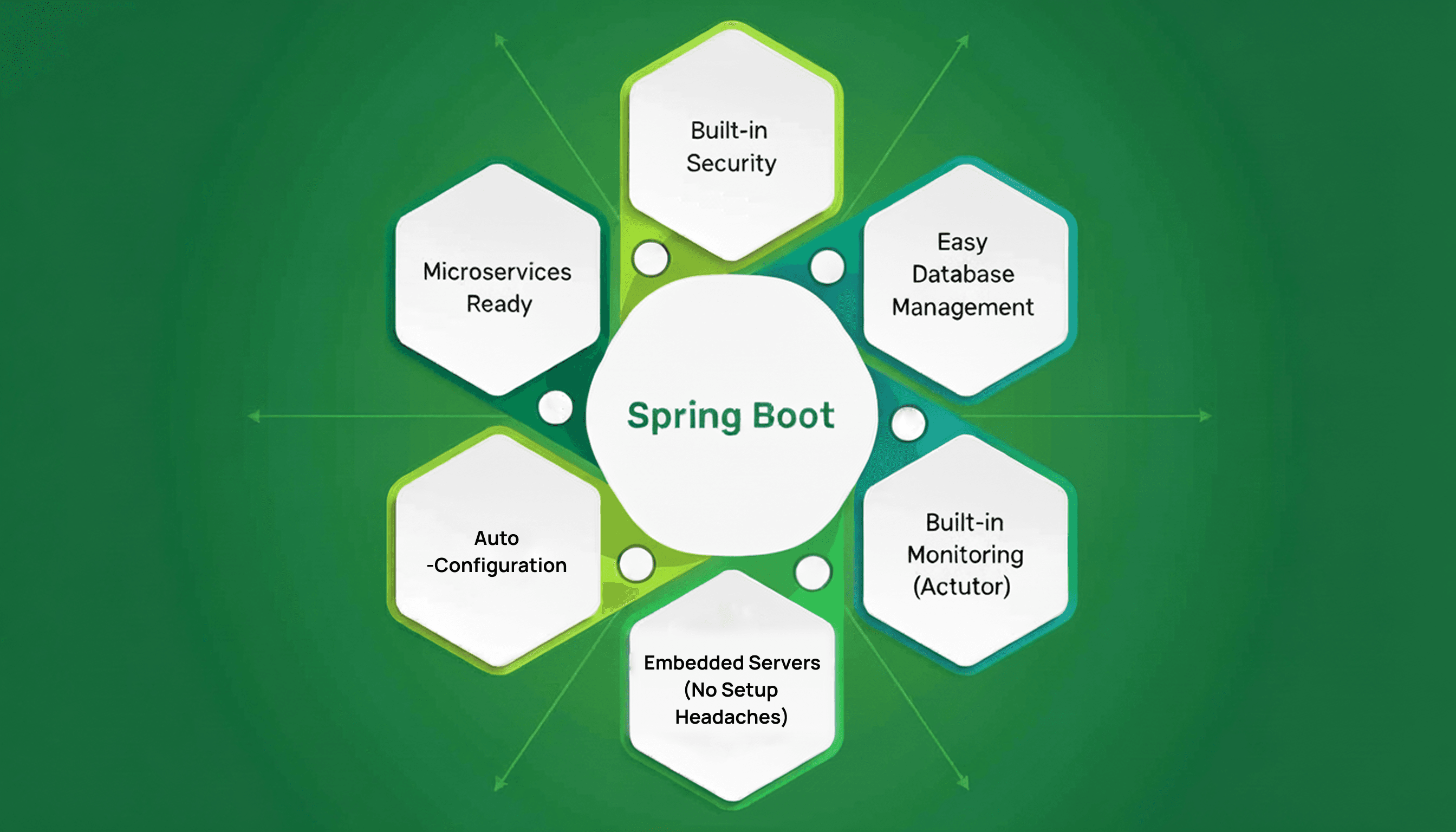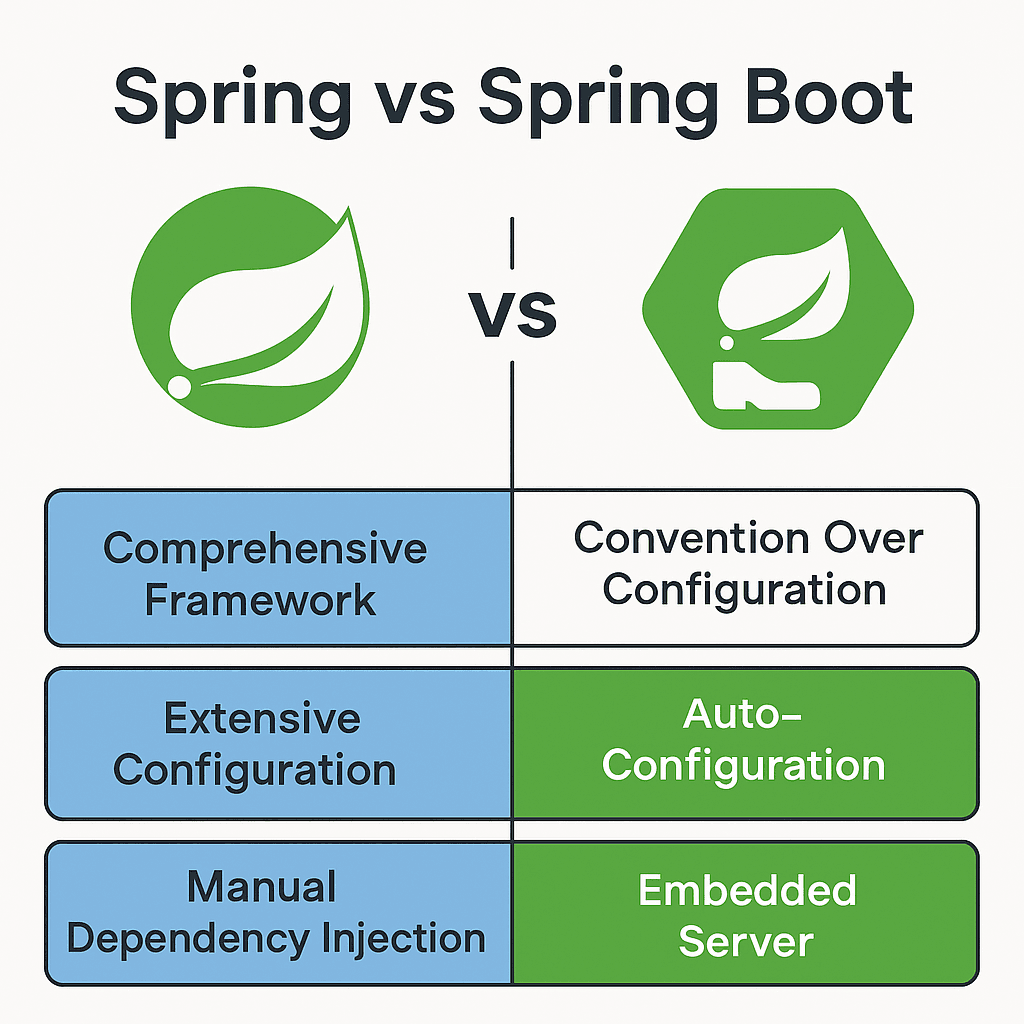Why Spring Boot is the Best Choice for Building Enterprise Applications
Spring Boot | Nexsaar
1. Why Spring Boot is the Best Choice for Building Enterprise Applications
Building software for businesses is like constructing a building—you need strong foundations, good tools, and reliable parts that fit together perfectly. For enterprise applications, Spring Boot is a standout choice. Here’s a simple, practical guide to why.
What is Spring Boot?
Think of Spring Boot as a smart toolkit for building business software in Java. Instead of starting from scratch, you get a pre-built foundation with sensible defaults.
👉 If regular programming is like building a car from separate parts, Spring Boot is like getting a car kit with most parts pre-assembled—you just add your custom features.
Spring Boot Features

Why Other Frameworks Struggle for Enterprises
-
Express.js (JavaScript)
- Like having only a hammer in your toolbox—you’ll spend time wiring everything (security, database, sessions).
- You assemble everything yourself (auth, validation, observability).
-
Django (Python)
- A Swiss Army knife—lots built-in, but deep customization for complex needs can get tricky.
- Customizing ORM behavior or advanced auth flows can slow you down.
-
Ruby on Rails
- Shines for rapid CRUD apps, but large, highly concurrent systems can hit performance ceilings.
- Heavy tuning needed for concurrency at scale.
👉 These frameworks are great in many contexts, but enterprise needs (security, scale, complex domains, observability) are where Spring Boot’s ecosystem really shines.
Spring Framework vs Spring Boot Comparison

Spring Boot Superpowers
- Built-in Security
- Spring Boot integrates Spring Security out of the box.
// build.gradle
implementation 'org.springframework.boot:spring-boot-starter-security'
// SecurityConfig.java
@EnableWebSecurity
public class SecurityConfig {
@Bean
SecurityFilterChain filterChain(HttpSecurity http) throws Exception {
http
.authorizeHttpRequests(auth -> auth
.requestMatchers("/actuator/health").permitAll()
.anyRequest().authenticated())
.httpBasic(Customizer.withDefaults()); // swap for JWT/OAuth later
return http.build();
}
}- Easy Database Management
- Spring Data JPA removes tons of boilerplate.
// build.gradle
implementation 'org.springframework.boot:spring-boot-starter-data-jpa'
runtimeOnly 'com.mysql:mysql-connector-j'
// Customer.java
@Entity
public class Customer {
@Id @GeneratedValue(strategy = GenerationType.IDENTITY)
private Long id;
private String name;
private String email;
}
// CustomerRepository.java
public interface CustomerRepository extends JpaRepository<Customer, Long> {}
// CustomerController.java
@RestController
@RequestMapping("/api/customers")
public class CustomerController {
private final CustomerRepository repo;
public CustomerController(CustomerRepository repo) { this.repo = repo; }
@GetMapping public List<Customer> all() { return repo.findAll(); }
@PostMapping public Customer create(@RequestBody Customer c) { return repo.save(c); }
}- Built-in Monitoring
- Spring Boot Actuator gives health checks and metrics.
// build.gradle
implementation 'org.springframework.boot:spring-boot-starter-actuator'Application properties
# application.properties
management.endpoints.web.exposure.include=health,info,metrics
management.endpoint.health.probes.enabled=trueGrafana Monitoring Dashboard for Spring Boot

- No Setup Headaches
- Embedded servers (Tomcat/Jetty/Undertow) included.
./gradlew clean bootJar
java -jar build/libs/app-0.0.1-SNAPSHOT.jar- Microservices Ready
- With Spring Cloud, you get service discovery, config management, gateways, and resilience patterns.
Spring Cloud Microservices Architecture

| Framework | Requests/sec (illustrative) | Takeaway |
|---|---|---|
| Spring Boot | 243,639 | Excellent headroom for scale |
| Express.js | 78,136 | Good, but needs careful assembly |
| Ruby on Rails | 42,546 | Fair; tuning required |
| Django | 32,651 | Solid, typically slower |
👉 Takeaway: Spring Boot handles significantly more concurrent users, giving you breathing room as traffic grows.
Enterprise Features That Matter
- Transaction Management
@Transactional
public void transfer(Long fromId, Long toId, BigDecimal amount) {
accountService.debit(fromId, amount);
accountService.credit(toId, amount);
}- Cloud-Native Deployment
// dockerfile
FROM eclipse-temurin:21-jre
WORKDIR /app
COPY build/libs/app-0.0.1-SNAPSHOT.jar app.jar
EXPOSE 8080
ENTRYPOINT ["java","-jar","/app/app.jar"]- Extensive Documentation & Community
Millions of developers, guides, and answers—rarely get stuck.
Real-World Success Stories
- Netflix → Uses Spring for millions of concurrent requests.
- Major Banks & FinTech → Rely on Spring for robust security & transactions.
👉 If it works for the world’s biggest streaming and finance workloads, it’s a safe bet.
When to Choose Spring Boot
Choose Spring Boot when you need:
✅ Security (banking, healthcare, e-commerce)
✅ Growth (startups → large scale)
✅ Reliability (systems that must not crash)
✅ Speed (faster development & delivery)
✅ Longevity (long-term ecosystem support)
Quick Start: 5 Steps
- Open Spring Initializr
- Choose Gradle or Maven, Java 21+, add dependencies (Web, JPA, Security, Actuator).
- Download the project.
- Open in IDE (IntelliJ, VS Code, Eclipse).
- Run and start building features.
Summary
Spring Boot is like choosing a reliable, feature-rich car for a cross-country trip. While other frameworks work for simpler projects, Spring Boot gives enterprises:
- ✅ Security from day one
- ✅ Performance that scales
- ✅ Actuator metrics and health checks
- ✅ Simple deployment to cloud or Kubernetes
- ✅ Huge ecosystem & community support
For ERP systems, financial platforms, or any business-critical software, Spring Boot isn’t just a good choice—it’s the smart choice.